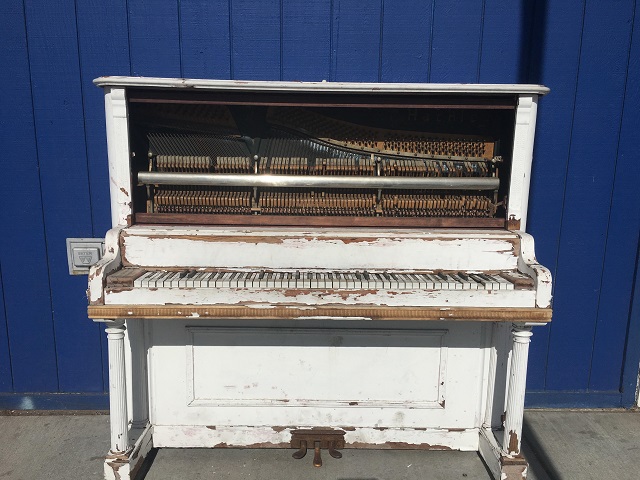There it was—a topless white piano. Her 88 breasts exposed to South Broadway, rusted and dusty and bare.
Perhaps she once belonged to a little girl with great potential, her saddle shoes not quite reaching the brass pedals at the Butterworth Center recital, where she skipped an entire stanza of “Für Elise.”
Maybe, she was once the color of maple syrup, selected by that new music teacher—the soprano with the slight limp and the missing wedding ring—for the music room at P.S. 22, back when they had funds for the arts. Maybe, she was painted white for a female folk band—who now plays at farmer’s markets on Sunday mornings in Brooklyn—their melodies wafting between the kimchi and kombucha.
Maybe, it’s been in an alley, rotting since it was pushed out the back door by a man whose wife, Irma—now dead and buried—used to play “Man from Snowy River” again, and again, and again.
What is the life of a piano?
She was an upright. Wide. Flat. Tall. Like a sturdy woman. Her edges were brown, paint just an idea from a past life. Time. Sun spots. Arms stiff at her sides from years of holding space for mediocre musicians.
She felt vintage. Maybe even Vaudeville. She denied the silk flowers of the spinet—so popular in the living rooms of 1980s parents who forced piano lessons on their children. She said “no” to Hummels and to black silhouettes in gilded gold frames. She didn’t need decoration. She was secure enough by herself. Eighty-eight keys.
I mean, who was she kidding. She was a big f*cking deal.
What is the life of a piano?
It’s not a guitar. It can’t be carried to the beach. Strapped to a backpack that later sunk to the bottom of the Mississippi River one night, when the ice looked so much stronger than it was. Played by tobacco-stained fingers at an olive farm in Southern Turkey. Carried from Canada through the Dakotas and Nebraska and across Kansas to Austin by a girl whose lipstick was a little too bright.
It’s not a meticulous instrument that fits inside a case, that fits inside the life of a symphony-orchestra musician, a guy who awakes every morning at 4:47, and serves whiskey sours to 20-somethings in a lounge that used to be a funeral home.
This piano can hardly be moved. It is—as if giving the finger to our flimsy society—unlike everything else. It is immobile. Heavy. Permanent.
What is the life of a piano?
Is she asleep? Unconscious? Can she still make music? Can she still hum? Can she even speak? Or is it too late? Is the music all in her mind now?
Did her wheels meet too much gravel? Were there cold drafts that drifted through back doors held open with a rock, cigarette dropped, and sometimes propped around its frame. Stale dreams.
At some point, performers began to refuse. They say she’s out of tune—with the world. Her keys soft and yellow, like teeth.
But if they would play her, they would see…that cracks, and bruises, and callouses only add to the songs.
And as her cracks widened across time, light came shining through.
Light that told her she wasn’t alone, that she wasn’t the only one who heard voices. Or, the only one who cried at inappropriate times.
Or, the only one whose bones ached—still ache, sometimes—with an undefined longing.
What is the life of a piano?
~
Author: Andrea Enright
Image: Max Pixel; author’s own
Editor: Yoli Ramazzina
Copy editor: Catherine Monkman
Social editor: Cat Monkman












Read 0 comments and reply